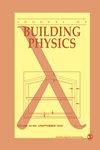砌体墙体的热阻:影响因素、评价及改进的文献综述
IF 1.4
4区 工程技术
Q3 CONSTRUCTION & BUILDING TECHNOLOGY
引用次数: 19
摘要
提高砌体墙体系统的热阻是降低砌体建筑运行能耗的有效途径之一。更新、更严格的能源法规也要求这种增长。但砌体墙体的有效热阻(r值)受诸多因素的影响,如热桥接,发生在高导电性结构构件穿透保温材料的地方。当将砌体贴面连接到结构备份墙时,热桥接很常见。此外,在热设计改进和规范符合性计算中,需要快速精确地估计r值的方法。本研究对影响砌体墙体整体热工性能的关键因素、有效估算和测量r值的方法以及热工设计的改进进行了全面的文献综述。除了确定主要的技术和实践挑战以及在每个方面取得的相应进展外,还讨论了关键的设计考虑因素,例如符合规范,材料特性,绝缘类型和位置,以及特殊的领带和货架角度类型。本研究总结了关键信息和建议,将有助于改善砖石墙的热设计,从而减少建筑物的能源消耗。本文章由计算机程序翻译,如有差异,请以英文原文为准。
Thermal resistance of masonry walls: a literature review on influence factors, evaluation, and improvement
Increasing the thermal resistance of masonry wall systems is one of the effective ways to reduce energy consumption in the operation of masonry buildings. This increase is also demanded by newer, more stringent energy codes. However, the effective thermal resistance (R-value) of masonry walls is affected by many factors, such as thermal bridging, which occurs in places where highly conductive structural components penetrate insulating materials. Thermal bridging is common when connecting masonry veneers to structural backup walls. Furthermore, quick and precise methods for estimating the R-value are needed for thermal design improvements and code-compliance calculations. This study presents a comprehensive literature review on key factors that influence the overall thermal performance of masonry walls, methods to effectively estimate and measure R-values, and improvements in thermal design. In addition to identifying the main technical and practical challenges and the corresponding progress made on each front, key design considerations, such as code compliance, material properties, insulation types, and location, as well as special ties and shelf angles types, are also discussed. This study summarizes critical information and recommendations that will help improve the thermal design of masonry walls, hence reducing the energy consumption of buildings.
求助全文
通过发布文献求助,成功后即可免费获取论文全文。
去求助
来源期刊

Journal of Building Physics
工程技术-结构与建筑技术
CiteScore
5.10
自引率
15.00%
发文量
10
审稿时长
5.3 months
期刊介绍:
Journal of Building Physics (J. Bldg. Phys) is an international, peer-reviewed journal that publishes a high quality research and state of the art “integrated” papers to promote scientifically thorough advancement of all the areas of non-structural performance of a building and particularly in heat, air, moisture transfer.
 求助内容:
求助内容: 应助结果提醒方式:
应助结果提醒方式:


